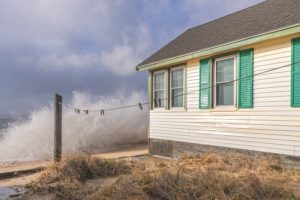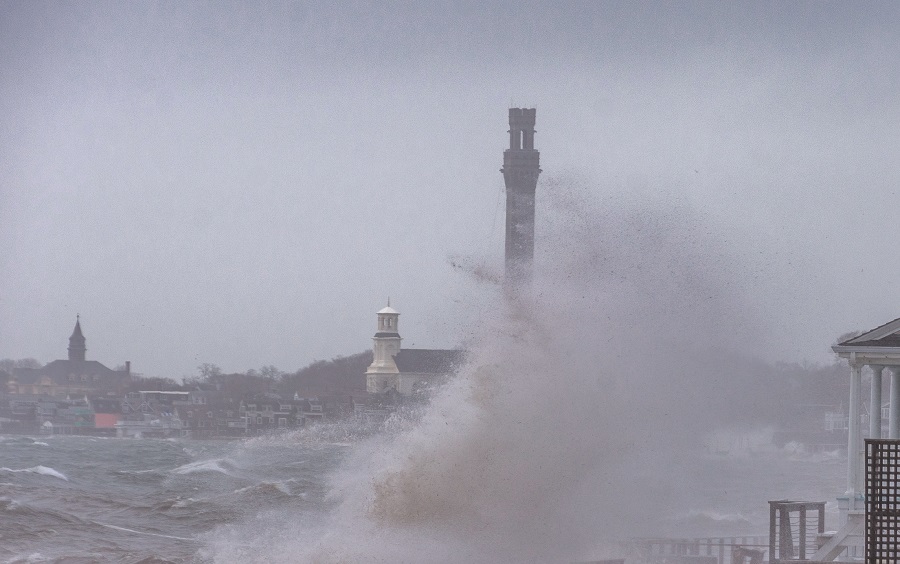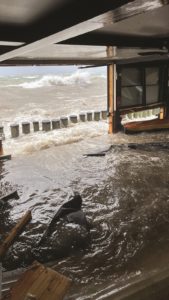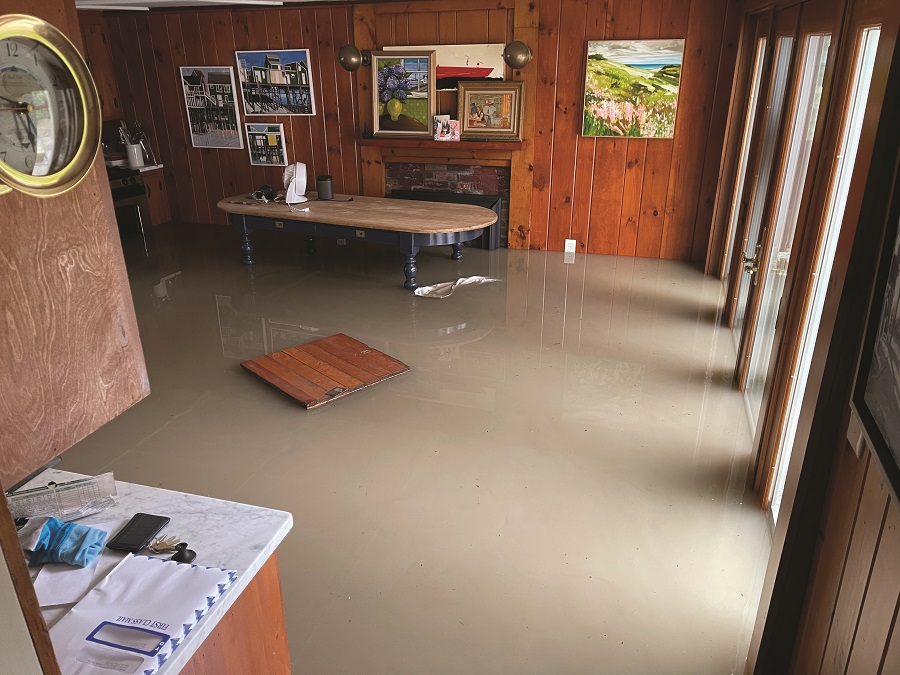PROVINCETOWN — The winter storm that brought much of North America to a halt last week was also cruel in Provincetown, where the harbor was whipped into a violent flood by intense winds, low pressure, and an approaching astronomical high tide.

All day on Dec. 23, powerful waves smashed into the coastal defenses of Provincetown’s East End, creating salt sprays as tall as houses and destroying stairways, docks, and decks all along the waterfront. That morning’s high tide also lifted the waters up and over several low-lying spots along Commercial Street, turning roads and alleys into rivers of seawater that swamped many homes and businesses.
Fanizzi’s Restaurant, which faces the water, took a direct hit, with waves smashing through a wall and flooding the dining room in three feet of water. Just a bit further west, seawater flowed over Commercial Street near the Icehouse condominiums and formed a river down Howland Street to Bradford Street, where it pooled into a saltwater lake two to three feet deep. The East End Market at 212 Bradford St. was flooded with salt water, as were numerous homes and basements in the area.

The damage was not quite as severe further west, especially compared to the Jan. 4, 2018 storm that caused major flooding in Provincetown. Spots flooded by that storm five years ago — it turned Gosnold Street into a river of seawater and a stretch of Bradford Street near town hall into a four-foot-deep lake — were mostly unaffected last week.
Some parts of the West End were inundated, however, including the triple intersection of Commercial, Franklin, and Tremont streets — an area that was unscathed in 2018. Along the waterfront, the damage was severe, with structures like decks and staircases disappearing altogether.
Fanizzi’s Restaurant
Paul Fanizzi, the owner of a waterfront restaurant since 2001, has seen storms like this before. The two restaurants that preceded his, Don’s Café and Pucci’s Harborside, each took their turns flooding. His dining room flooded in a storm on Nov. 6, 2002, Fanizzi said, and the basement was badly damaged in the January 2018 storm.

“Tom Pucci owned this restaurant before me, and after his last storm, he called Coastal Engineering Company and they designed the dining room with panels that will break in a storm,” Fanizzi said. The panels are supposed to flip and allow the room to flood, Fanizzi said, to prevent the structure from breaking.
The panels didn’t work quite as intended, Fanizzi said: “It left the building — we looked for it, and it’s gone.” The basement and kitchen areas were undamaged, though, and the bar saw only about three inches of water. Fanizzi expects to follow his playbook from the reconstruction in 2002 and open the bar and streetside dining room to patrons within a few weeks.
The harborside dining room will take longer, he said.
“One problem is windows,” Fanizzi said. “I need 50 windows, and because of what’s going on in the world, they think it will take 8 to 10 weeks to get them.
“I’m also hoping the town will let us get our emergency permits,” he added. “You have to get permits to work on the water.”
Flood insurance covers a lot of the physical costs of reconstruction, Fanizzi said, but not any of the costs of being closed. Business interruption insurance has never paid him anything in 22 years, he added.
But the community has been incredibly generous, he said. An online fundraising campaign to help support the 32 year-round employees of the restaurant had raised almost $47,000 when this edition of the paper went to press. So many people tried to come help clear the restaurant of debris that the town’s building inspector had to order everybody out, Fanizzi said.
“This is why you stay,” said Fanizzi. “No matter what circumstance you’re in, the community, the people here help you.”
A River of Salt Water
Quinn Taylor, owner of Café Heaven in Provincetown’s West End, lives in the ground floor unit of the historic Captain Dyer house in the East End. He had crossed the street to watch the waves hitting the seawall at the Icehouse condominiums on the morning of Dec. 23 and then gone home to shower. When he stepped out of the bathroom, he realized his back yard was full of seawater.

“There was a river flowing down Daggett Lane, past my car, and into my back patio,” Taylor said. Very quickly, the water was inside his kitchen, which is almost three feet lower than the rest of the house.
The water, he said, didn’t just come through the door frame. “There was water coming up through the heating vents in the floor, and even between the floorboards,” Taylor said.
He called a friend, and together they piled rugs, clothes, and other belongings onto the tops of beds and dressers. The water in the main part of his home topped out at around three inches, Taylor said, so most of his furniture was not destroyed.
Nonetheless, when they saw the home’s propane tanks floating around the back yard, Taylor and his friend Peter Sullivan decided it was time to leave the building.
They left via the property’s front yard, which lies well below Commercial Street. “The water was about an inch below my chest,” Taylor said. They made their way down Howland Street to Sullivan’s car, passing the flooded East End Market on their way.
East End Market
Oriana Conklin bought the East End Market on Bradford Street last March, and she still lives in a manager’s apartment next to her longtime workplace, Bubala’s Café. She was watching the Dept. of Public Works try to rebuild a washed-out berm at the Court Street landing next to her apartment when her employees — Ian Schillinger, Carly Hill, and Chris Souza were working at East End that day — called to tell her there was water coming into her shop.

“Carly sent me a video at 10:30 a.m. and said, ‘There’s water around the building. I don’t think we can leave, and I don’t think you can get in,’ ” Conklin said. “I said, ‘Oh, I’m getting in.’ ” She drove over and parked on Howland Street.
By the time Conklin made it to the market, there were two feet of seawater in the kitchen and about a foot and a half on the shop floor. Her employees told her the water came in incredibly quickly, going from a trickle to a flood in just 30 seconds.
At first, Conklin and her staff tried to move inventory up onto countertops. Conklin put on a pair of waders that she kept at the market. Within 20 minutes, however, the fire dept. was telling everyone to evacuate the shop due to the risk of electrocution from flooded refrigeration machines.
“I emptied the safe, we grabbed our bags, and we left,” Conklin said. About three hours later, when the water had drained enough, she, her staff, and 12 volunteers returned to begin cleaning up.
Conklin’s friend Marc Guerrette borrowed banquet tables from the Crown & Anchor, and they set prepared foods out on the sidewalk for passersby to take, Conklin said. “The next day, 15 people came to help me again,” she said.
Four refrigerators were destroyed by the flood, Conklin said, and the floors in her kitchen are no longer safe. She does not know when she can reopen. Nonetheless, she pointed to the support she has received from the community. By this issue’s press time, an online fundraising campaign to support the market’s employees had raised almost $23,000.
“The GoFundMe will help a lot, because people will still be getting paid,” said Conklin. “That’s a godsend. We can’t get the disaster relief company to come until Wednesday, but the community has been amazing.”
Lake Franklin
In the West End, many of the businesses that flooded in the 2018 storm did not flood this time, and one of the key variables seems to have been electricity. In 2018, the storm took the power out, disabling sump pumps in basements all over town. This time, most of the town never lost power.

It was still a close call, said Billy Williams, owner of Perry’s Liquors at the corner of Commercial, Franklin, and Tremont streets. Salt water filled the streets and came just an inch or two away from a delivery hatch that leads to the basement. The DPW cleared away leaves and debris from the storm drains, Williams said, which helped drain the lake just as it was about to flood his building.
“Our manager, Carmen DaSilva, was there to receive a delivery, just by chance, when the water started flooding the intersection,” Williams said. “She and her girlfriend were telling people driving by to slow down, because the cars were splashing the water higher and it was about to breach the building.”
DaSilva called Williams, who was visiting family in Colorado, and he called the DPW to ask for help with the storm drain. It had been partially blocked since the fall, he said.
“Storm sewers and street sweeping — these are not just aesthetic,” said Williams. “They serve a purpose.” Williams said that street cleaning had either stopped or slowed dramatically this fall, and he was not surprised there was enough debris on the streets to clog the drain.
The DPW came quickly, Williams said, and the water began to drain away faster than the storm could replace it. “Lake Franklin,” as DaSilva had dubbed it, began receding.
“I know that my neighbor two houses down had a flooded cellar,” Williams said. But the West End seemed to have more near misses than direct hits from this storm.



